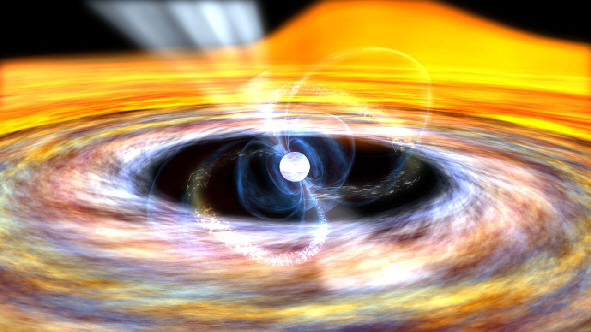Life’s not too good if you’re the companion of a black widow. Here on Earth, spiders by that name feast on their smaller significant others after mating. Out in space, some weird objects do the same thing to their closeby neighbors. They’re rapidly spinning neutron stars that slowly destroy their companion stars with powerful outflows of high-energy particles. A team at the University of California Berkeley is studying one of these so-called “black widow pulsars”, called PSR J0952-0607. Thanks to its hefty appetite, it shredded and consumed nearly all of its stellar companion. That eating spree made it the heaviest known neutron star to date.
Meet the Neutron Star that Ate Its Neighbor

PSR J0952-0607 is a dense, collapsed star that’s spinning a record 707 times per second. That rotation rate makes it a millisecond pulsar. It’s basically a giant ball of neutrons, compressed very tightly by gravity. That crushes the material inside into a weird quantum state. The mass is 2.35 times the mass of the Sun. That puts it at the upper limit of mass for such exotic objects. The interior is likely to be a soup of neutrons as well as up and down quarks (which make up normal protons and neutrons).
It turns out that the quantum weirdness inside PSR J0952-0607 makes it a prime target for further research. Alex Filippenko, Distinguished Professor of Astronomy at UC Berkeley, described the strange appeal, particularly in the neutron star’s interior. “We know roughly how matter behaves at nuclear densities, like in the nucleus of a uranium atom,” he said. “A neutron star is like one giant nucleus, but when you have one-and-a-half solar masses of this stuff, which is about 500,000 Earth masses of nuclei all clinging together, it’s not at all clear how they will behave.”

Studying a Neutron Star Black Widow
Filippenko and collaborator Roger Romani, a professor of physics at Stanford University, along with graduate student Dinesh Kandel, co-authored a paper about this object. They have been studying black widow pulsars like this one. They hope to answer questions about these objects, like, how large can neutron stars/pulsars grow? To find out, the team studied this pulsar using the 10-meter Keck I telescope on Maunakea in Hawai’i. The observations gave a precise measurement of the neutron star’s mass. They also took a spectrum of what’s left of the hot, glowing companion star. It was reduced to the size of a giant planet by the cannibalization action of the massive neutron star.
“By combining this measurement with those of several other black widows, we show that neutron stars must reach at least this mass, 2.35 plus or minus 0.17 solar masses,” said Romani, who is a professor of physics at Stanford and a member of the Kavli Institute for Particle Astrophysics and Cosmology. “In turn, this provides some of the strongest constraints on the property of matter at several times the density seen in atomic nuclei. Indeed, many otherwise popular models of dense-matter physics are excluded by this result.”
Spinning Up and Eating a Companion
Many “ordinary” pulsars spin on their axes about once per second. Some, like PSR J0952-0607, spin faster, up to a thousand times per second. That’s unusual, especially if the normal rotation rate of the star that collapsed to become the neutron star was normal. So, why would a millisecond pulsar spin so rapidly? One idea is that it stripped its companions down to just about nothing.
“The evolutionary pathway is absolutely fascinating. Double exclamation point,” Filippenko said. “As the companion star evolves and starts becoming a red giant, material spills over to the neutron star, and that spins up the neutron star. By spinning up, it now becomes incredibly energized, and a wind of particles starts coming out from the neutron star. That wind then hits the donor star and starts stripping material off, and over time. The donor star’s mass decreases to that of a planet, and if even more time passes, it disappears altogether. So, that’s how lone millisecond pulsars could be formed. They weren’t all alone to begin with — they had to be in a binary pair — but they gradually evaporated away their companions, and now they’re solitary.”
The pulsar PSR J0952-0607 and its faint companion star support this origin story for millisecond pulsars. “These planet-like objects are the dregs of normal stars which have contributed mass and angular momentum, spinning up their pulsar mates to millisecond periods and increasing their mass in the process,” Romani said.
“In a case of cosmic ingratitude, the black widow pulsar, which has devoured a large part of its mate, now heats and evaporates the companion down to planetary masses and perhaps complete annihilation,” said Filippenko.
For More Information
Heaviest neutron star to date is a ‘black widow’ eating its mate
PSR J0952-0607: The Fastest and Heaviest Known Galactic Neutron Star

